-
Paper Information
- Previous Paper
- Paper Submission
-
Journal Information
- About This Journal
- Editorial Board
- Current Issue
- Archive
- Author Guidelines
- Contact Us
International Journal of Electromagnetics and Applications
2012; 2(2): 6-10
doi: 10.5923/j.ijea.20120202.02
Numerical and Experimental Analysis of Microstrip Antennas Loaded with a Single DNG Resonator
Fabio Urbani , Luis D. Quintero
Department of Engineering, The University of Texas at Brownsville, Brownsville, 78520, USA
Correspondence to: Fabio Urbani , Department of Engineering, The University of Texas at Brownsville, Brownsville, 78520, USA.
| Email: |  |
Copyright © 2012 Scientific & Academic Publishing. All Rights Reserved.
This paper deals with the numerical and experimental analysis of the effects of non-conventional materials on antenna performance. The paper is divided into two main sections: numerical simulations and experimental characterization. First, a microstrip antenna loaded with a Double-Negative (DNG) substrate is numerically simulated to study its effect on size and performance. Then the same antenna using conventional substrate is top loaded with a novel single-sided resonator (referred as diamond dipole resonator or DDR) showing DNG behavior. The antenna is manufactured and measurements are performed. The results show that the use of the DDR produces a dramatic 73.9% return loss improvement as well as a frequency shift. Issues about size reduction and negative refractive index effects are further presented and discussed.
Keywords: DNG: Double-Negative material, SRR: split ring resonator, FSS: Frequency Selective Surfaces, HFSS™: High Frequency Structure Simulator, DDR: diamond dipole resonator
Article Outline
1. Introduction
- Recent research on antennas based on non-conventional materials has indicated many advantages over those of traditional dielectric substrates, which make them a new borderline for microwave design. Using non-conventional materials is a potential and promising solution to size reduction, increased bandwidth and obtaining multiple resonances. The proposed paper intends to carry out numerical and experimental investigation of metamaterial-based microstrip antennas. Recent developments in most consumer electronic products are toward miniaturization. The technology of integrated circuit is widely applied in the field of communication baseband modules and RF modules to make communication products smaller in size. However, the technology of integrated circuits is difficult to use to design a compact antenna and antenna arrays. Therefore, the design of compact planar structures becomes a critical technique to reduce the size of communication products. In recent years, novel engineered materials with characteristics that may not be found in nature have been considered in the design of microwave antennas and arrays. The studies in the area showed increased directivity and bandwidth, reduced observability, and frequency shift that can be used to reduce dimensions for fixed working frequencies[1] –[6]. These encouraging results are the leading idea behind the present work. Artificial material with novel electroma- gnetic properties are often conceptualized and realized as particulate composite materials. If the particles are electrically small, the effective constitutive parameters and properties can be estimated via various homogenization formalisms. The synthesis and fabrication of new materials has to be matched by the development of new experimental characterization techniques. The novel electromagnetic performance can be usefully employed to substantially reduce the patch size with a corresponding improvement in terms of weight and space occupation[7]-[8].Currently, DNG materials for antenna applications are used to replace conventional substrates. To this end, the substrate is conceived as a periodic repetition of a single unit called unit-cell. This approach entails a considerable effort from a simulation and manufacturing point of view. In order to simplify both the simulation and manufacturing efforts, this paper proposes to use one single-unit resonator to analyze its effect on the antenna performance and hence, confirm the advantages mentioned above. The structure of the paper is as follows. In section 2 microstrip antenna design formulas are provided. The results from numerical simulations are reported in Section 3. Sections 4 and 5 explain the theoretical methodology behind the proposed approach and the novel DNG geometry adopted. In Section 6 experimental results to show the capabilities and the effectiveness of the design technique developed in the paper are reported.
2. Antenna Design
- Within the microwave and millimeter wave frequencybands, microstrip antennas (MSA) have proved to be excellent radiators for many applications in the commercial and specialized application frequency domains of microwaves and millimetre waves. Aircraft and ship antennas, satellite communications, mobile radio, and biomedical are just few of the application areas of such devices. A MSA consists of a radiating patch on one side of a dielectric substrate that has a ground plane on the opposite side. The radiating patch dimension width (W) and length (L) are related to the substrate relative permittivity and thickness through the transmission line model as follows[9]:
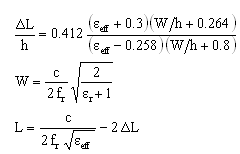 | (1) |
 | (2) |
3. Numerical Simulation
- A micro strip fed patch antenna working at 10GHz and loaded with conventional FR4 material was simulated. The resonant frequency is chosen in order to match with the frequency where the metamaterial displayed double negative properties. The antenna was then simulated on a dielectric slab modelled to have the same parameters as that of the metamaterial. The DNG patch antenna was then shrunk until it operated at the same frequency as that of the patch antenna that used the conventional dielectric. The original patch size, with the conventional dielectric, was 13 mm by 16 mm. By shrinking the patch to 9.94 mm by 8.94 mm, while using the metamaterial for the dielectric, the antenna resonated at the same frequency as that of the antenna with the conventional dielectric. This provided a 57 percent decrease in the area of the antenna’s patch and a 26.9% of bandwidth improvement. A result comparison is showed in Table 1[10].
| ||||||||||||||||||
4. Electromagnetic Parameters Retrieval
- As stated in the introduction, an important rule when designing a metamaterial is to keep the size and periodicity of the scattering elements significantly smaller than the operating wavelength (λ0/10 or smaller) as this allows for meaningful interpretation of the material's bulk properties based on the behavior of the unit cell (effective medium). Nevertheless, this paper proposes a scattering element with dimensions that resemble the wavelength in free space. Given the unit-cell size, the proposed structure cannot be classified as bulk metamaterial, which is conceived as discrete media composed of a combination of unit cells of small electrical size at the frequency of interest[11]-[14]. Experimental analysis will show that such a medium presents DNG behavior and that the effective medium theory can still be applied. In addition, the novel designed implant is single sided which improves and simplifies the manufacturing process. The permittivity ε and the permeability μ for a DNG medium must be simultaneously negative over a certain frequency range. In order to achieve this result several numerical and experimental models have been proposed in the literature[15]. The model proposed in this paper consists of diamond ring resonator and wire strips on a hosting isotropic dielectric medium (Fig. 1).Once the effective medium theory can be applied, the engineered medium can be characterized through macroscopic parameters such as dielectric permittivity and magnetic permeability. The characterization can be carried out by applying a parameter retrieval procedure based on the calculation or measurements of scattering parameters followed by the derivation of macroscopic indicators such as refractive index n and wave impedance z. The S-parameter retrieval techniques that have been utilized recently to characterize metamaterials have been shown to be valid for metamaterials having symmetric unit cells, even when the optical path length (kd) is on the order of the unit cell size. The refractive index and the wave impedance can be related to the calculated scattering parameters as follows:
 | (3) |
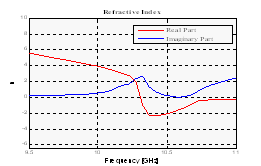 | Figure 1. Novel proposed single-sided Diamond Dipole Resonator (DDR) |
5. Diamond Dipole Resonator
- The DNG behavior of an artificial material can be obtained through the introduction of conductive impurities in a host medium. The shape of the inclusions is chosen according to two main factors: a) it must provide the double-negative behavior to the hosting dielectric medium; and b) it must take into account manufacturing limitations. The former guarantees that the shape contributes to a simultaneous formation of both electric and magnetic dipole moments while the latter assures that the shape can be manufactured according to the current technology. In this paper a novel single-sided metamaterial, referred as diamond dipole resonator (DDR), is proposed to improve antenna performance. The novel designed unit cell shows DNG behavior at about 10 GHz (Fig. 2), allowing the metallization to be located only on one side of the dielectric slab, thus simplifying the manufacturing process[18].
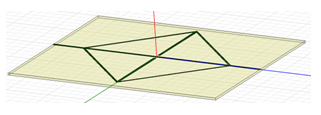 | Figure 2. DDR refractive index obtained from the parameter retrieval |
6. Experimental Results
- DNG metamaterial structures can be used to introduce changes in antenna impedance and, consequently, to obtain improvement in antenna response. However, currently available metamaterial-loaded antennas at RF and microwave frequencies are restricted in their overall miniaturization due to limitation in packing several metamaterial inclusions in a small volume, in part due to having metallization on both sides of the dielectric slab. Moreover, multiple scattering from such inclusions causes impurities in polarization. Being able to employ a single DNG micro-resonator instead of an array would address both of these issues while adding ease of implementation. In this paper a single DNG DDR metamaterial inclusions is proposed to induce changes in a conventional microwave antenna behavior. The microstrip antenna is based on a 1.52 mm thick substrate (RO4350B) with a permittivity/dielectric constant of 3.66. The patch measures 9.6x6.6 mm and is fed with a λ/4 transmission line to match a 50 Ω characteristic impedance. The fabricated antenna shows excellent radiation properties with a total gain as high as 5 dBi (Fig. 3).
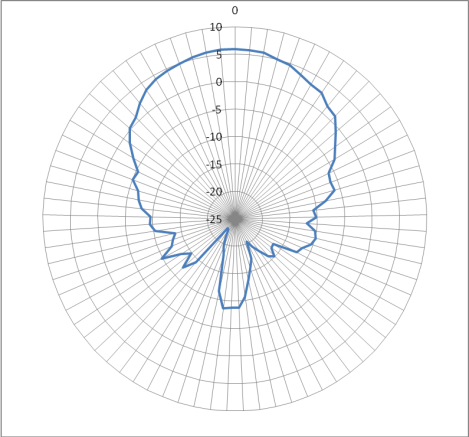 | Figure 3. Conventional MSA radiation pattern (vertical polarization). |
 | Figure 4. Microstrip antenna experimental results |
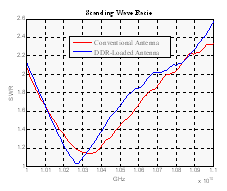 | Figure 5. SWR comparison. |
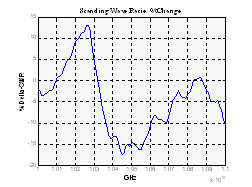 | Figure 6. SWR percentage change. |
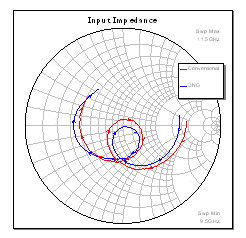 | Figure 7. Input impedance comparison. |
7. Conclusions
- The performance of a microstrip antenna on DNG layer was investigated using the commercial software HFSSTM and experimental measurements using a single DDR. The return loss was considered and a comparison between isotropic and DNG dielectric was carried out. From the results it can be highlighted that by using the DNG substrate a miniaturization is achievable with an improvement in weight and performance; also, the experimental results shown a return loss improvement of 73.9%. The benefits of using DNG materials in antenna design are also confirmed by other measured parameters such as VSWR and input impedance. The proposed technique allows achieving performance improvement in a very simple way.
 Abstract
Abstract Reference
Reference Full-Text PDF
Full-Text PDF Full-Text HTML
Full-Text HTML